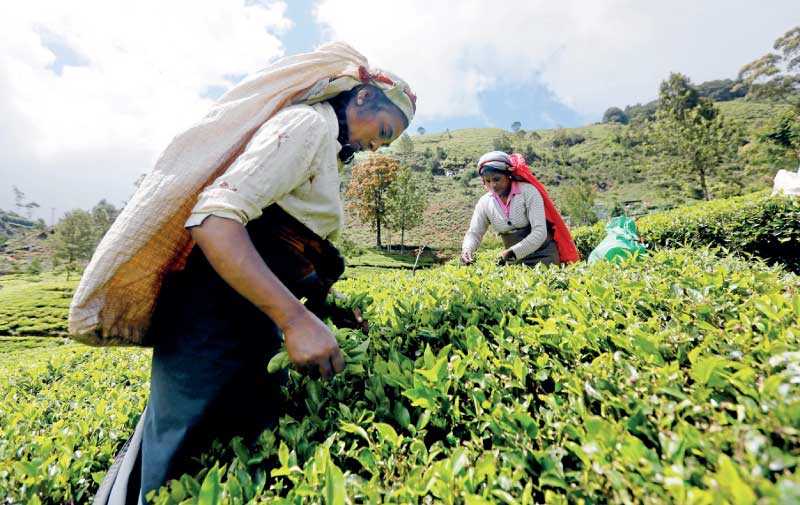Sunday Apr 20, 2025
Sunday Apr 20, 2025
Monday, 9 November 2020 00:11 - - {{hitsCtrl.values.hits}}

We are all advocates of our tea, and what hurts one sector of our industry will ultimately impact all of us. A paradigm shift is necessary, and it can only start with a long-overdue update to the way in which workers are paid
 With nearly 500,000 smallholders in total, the tea smallholder sector is a significant contributor to the production and output of Ceylon Tea in Sri Lanka, and across the globe. We are often called the ‘backbone’ of our tea industry, and with good reason.
With nearly 500,000 smallholders in total, the tea smallholder sector is a significant contributor to the production and output of Ceylon Tea in Sri Lanka, and across the globe. We are often called the ‘backbone’ of our tea industry, and with good reason.
A total of 16% of Sri Lanka’s arable land belongs to the tea sector. Of this, tea smallholders operate in 60% of the total tea land and account for more than 70% of the total tea produced. According to the Tea Control Act, tea lands between 20 perches and 10 acres are considered ‘Tea Small Holdings’ across the country.
I am a tea smallholder myself. My journey began in 1977 with a two-acre tea land. I now operate three small tea lands while simultaneously serving as the Chairman of the Sri Lanka Federation of Tea Smallholders. Running a smallholding over the past three decades (or more) has not been an easy feat. No matter how big or small your tea plot is, ensuring that the land is well managed, tea is correctly harvested, and the quality of Ceylon Tea is upheld are challenging standards to meet every day.
Currently, a great deal is being made about the tea industry and tea companies being in hot water over concerns on wages, productivity, output, and quality. As such we felt it was important to share lessons from a tea smallholder perspective to help refine best practices and discover a sustainable way forward.
It is essential that the industry – as a collective – ensures a paradigm shift in the way we’ve been managing this sector. While it is true that the industry was introduced by the British in 1867, the challenges we face today are totally different from then, and there is no reason as to why our management practices should not evolve with the times.
Basic industry dynamics
Tea smallholder plantations are found commonly across the island. Most low-country tea comes from plantations in Ratnapura, Galle, Matara and Kalutara. Mid-country smallholdings are widespread across, Kegalle and Kandy. Up-Country tea comes from Nuwara Eliya and Uwa.
A majority of tea smallholders are both managers and harvesters of their lands. Small tea plots are easy to manage, and if you own one, you and your family will likely tend to it. The larger the tea plot, the more decentralised management becomes – quite similar to the basics of how the much larger tea companies function. However, unlike the big tea companies – widely known as Regional Plantation Companies (RPCs) – smallholders are not bound by a ‘Collective Agreement’ when it comes to the matter of worker compensation.
Sri Lanka’s Industrial Disputes Act of 1950 defines the ‘Collective Agreement’ as an agreement relating to the terms and condition of employment of workmen in any industry. Within the tea industry, this agreement mainly focuses on worker remuneration and is renegotiated every two years.
With wage negotiations approaching early next year, industry actors across the board seem to be at cross-roads on the best way forward. The only point on which there seems to be much agreement is that reform is needed and urgently. This is a battle fought every two years, and unfortunately, there are no winners; only losers. By contrast, smallholders like us who are not bound by such an agreement have the independence to make decisions we feel are best for our workers, the industry and the legacy of Ceylon Tea.
While we use the Collective Agreement as a benchmark for the rate of payment, we have one crucial advantage, which is that we have the freedom to decide on the model of payment. For us, the Collective Agreement is only a guideline. Our main focus is therefore in ensuring that we are able to offer workers a method of payment that is attractive, while still remaining sustainable as a business.
Lesson from tea smallholders
Here’s how we work: As a baseline, tea harvesters are paid a rate of Rs. 30 for every kilo they harvest. Some harvesters pluck up to an average of 30 kgs on a good day. A good day is when the weather, the soil and harvesting practices are all in our favour. Leaves on each tea bush are harvested on rotation every seven to 10 days. This means that leaves from each bush are plucked at least three times a month.
A tea plot needs more than just the expertise of tea harvesters to yield a successful output. Besides tea harvesters, we also have other fieldworkers who engage in manual labour oriented tasks like weeding, manuring and up-keeping estate infrastructure who are paid a daily wage of Rs. 1,000. These fieldworkers work eight hours a day.
As illustrated above, for tea harvesters, our method of payment is far from an unrewarding, fixed daily wage model. Instead, each harvester is paid for the kilos of tea they yield – which is to say: a productivity linked model of remuneration.
Until the 2000s, like the RPCs, tea smallholders also paid harvesters and tea workers a daily wage. However, we found that this became a real challenge when trying to retain workers and maintain profitability, and so a collective decision was taken by tea smallholders to shift towards a productivity-linked wage, as we saw this to be far more efficient and effective for the industry.
Speaking from direct personal experience, the ability to remunerate tea harvesters based on output has been liberating for them and for myself. While this has helped me manage my tea lands better and yield higher output, it has also given me the time to venture into other areas of work I am passionate about.
For instance, I was able to pursue my passion of setting up the National Pre-School Development Foundation; this foundation aims to train pre-school teachers in Early Childhood Development within plantation communities. For tea harvesters, moving out of a daily payment system has opened up a path for them to secure higher earnings while increasing mobility of labour – meaning that workers were freed up to actively pursue work on different smallholder plots in order to boost their earnings even further.
Over the past few years, tea harvesters who work on smallholder plots have evolved into entrepreneurs themselves. Driven by the need to improve efficiency and output, harvesters themselves have become ‘agents of change’. Management and production practices have become smarter, output-oriented and have resulted in improvements in the quality of the tea leaf itself.
A recent study by the International Labour Organisation confirms these observations which I have personally witnessed over the years as a smallholder, namely: that casual workers engaged in tea smallholdings usually earn a higher daily wage compared to the plantation workers and contribute towards more productive work (Future of work for Tea Smallholders in Sri Lanka, ILO, 2018). This is simply due to the fact that the people we contract to work on our plots are paid solely based on their productivity.
Over the years, although the tea smallholder sector has evolved to suit the times, it is unfortunate that the rest of our industry has been held back from progress by forcing the continuation of a basic wage system that does not prioritise or sufficiently reward productivity. RPCs continue to play an important role in our industry – particularly in terms of upholding the international image and reputation of Ceylon Tea through their commitments to securing international standards and certifications.
Hence it is essential that the RPCs are able to continue operations in a sustainable manner. A collapse in the RPC sector would create major risks to the entire industry’s reputation for the highest quality standards and its capacity for innovation – given that more recent advancements in mechanisation, climate-friendly factories, use of drone technology and IT to optimise production and supply chain have only been made possible due to their investments. Such advancements can only be scaled down to provide benefits to tea smallholders once a path to implementation has been cleared by RPCs. Failure to facilitate this progress will ultimately jeopardise the sustainability of the entire industry.
Moreover, the first and most pressing solution to this dilemma is obvious to all parties. The wage model must be revised. Our experience as tea smallholders is clear proof of this fact and should not be lightly disregarded. We are all advocates of our tea, and what hurts one sector of our industry will ultimately impact all of us. A paradigm shift is necessary, and it can only start with a long-overdue update to the way in which workers are paid.
(The writer is the Chairman of the Sri Lanka Federation of Tea Small Holders. The Federation of Tea Small Holders is an industry body aimed at promoting the advancement and development of tea small holdings in the country. In 2018, tea small holders contributed to more than 70% of over the overall tea production in the country.)
Discover Kapruka, the leading online shopping platform in Sri Lanka, where you can conveniently send Gifts and Flowers to your loved ones for any event including Valentine ’s Day. Explore a wide range of popular Shopping Categories on Kapruka, including Toys, Groceries, Electronics, Birthday Cakes, Fruits, Chocolates, Flower Bouquets, Clothing, Watches, Lingerie, Gift Sets and Jewellery. Also if you’re interested in selling with Kapruka, Partner Central by Kapruka is the best solution to start with. Moreover, through Kapruka Global Shop, you can also enjoy the convenience of purchasing products from renowned platforms like Amazon and eBay and have them delivered to Sri Lanka.
Discover Kapruka, the leading online shopping platform in Sri Lanka, where you can conveniently send Gifts and Flowers to your loved ones for any event including Valentine ’s Day. Explore a wide range of popular Shopping Categories on Kapruka, including Toys, Groceries, Electronics, Birthday Cakes, Fruits, Chocolates, Flower Bouquets, Clothing, Watches, Lingerie, Gift Sets and Jewellery. Also if you’re interested in selling with Kapruka, Partner Central by Kapruka is the best solution to start with. Moreover, through Kapruka Global Shop, you can also enjoy the convenience of purchasing products from renowned platforms like Amazon and eBay and have them delivered to Sri Lanka.